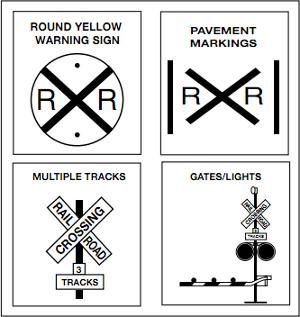Review Questions - Click On The Picture To Begin...

- Ignore all railroad crossing procedures
- Slow down and carefully check for other vehicles
- Buses are required to stop at all railroad crossings, including those marked exempt or abandoned
- Open the passenger door to listen for oncoming trains, but do not stop
Quote From The CDL Manual:
You do not have to stop, but you must slow down and carefully check for other vehicles:
- At street car crossings.
- At railroad tracks used only for industrial switching within a business district.
- Where a policeman or flagman is directing traffic.
- If a traffic signal shows green.
- At crossings marked "exempt" or "abandoned."
TruckingTruth's Advice:
These same rules about railroad crossings apply for hazardous material loads as well.
- Between 10 and 20 feet
- Between 5 and 25 feet
- Between 25 and 75 feet
- Between 15 and 50 feet
Quote From The CDL Manual:
Bus drivers are required to stop between 15 and 50 feet before railroad crossings. Listen and look in both directions for trains. You must lower the window and/or open the forward door to improve your ability to see or hear an approaching train. Then close the door prior to moving.
Before crossing after a train has passed, make sure there is not another train coming in the other direction on other tracks. If your bus has a manual transmission, never change gears while crossing the tracks.
You do not have to stop, but you must slow down and carefully check for other vehicles:
- At street car crossings.
- At railroad tracks used only for industrial switching within a business district.
- Where a policeman or flagman is directing traffic.
- If a traffic signal shows green.
- At crossings marked "exempt" or "abandoned."
TruckingTruth's Advice:
These same rules apply when carrying hazardous materials
- Do not talk with riders or engage in any other distracting activity while driving
- A bus is not allowed to transport intoxicated passengers
- Avoid fueling your bus with riders on board unless absolutely necessary. Never refuel in a closed building with riders on board.
- Do not tow or push a disabled bus with riders aboard either vehicle, unless getting off the bus would be unsafe
Quote From The CDL Manual:
Prohibited Practices:
- Avoid fueling your bus with riders on board unless absolutely necessary. Never refuel in a closed building with riders on board.
- Do not talk with riders or engage in any other distracting activity while driving.
- Do not tow or push a disabled bus with riders aboard either vehicle, unless getting off the bus would be unsafe. Only tow or push the bus to the nearest safe spot to discharge passengers. Follow your employer's guidelines on towing or pushing disabled buses.
- At least 75 feet
- At least 100 feet
- At least 50 feet
- At least 25 feet
Quote From The CDL Manual:
Bus drivers are required to stop at drawbridges that do not have a signal light or traffic control attendant. Stop at least 50 feet before the draw of the bridge. Look to make sure the draw is completely closed before crossing. You do not need to stop, but you must slow down and make sure it is safe when:
- There is a traffic light showing green.
- The bridge has an attendant or traffic officer that controls traffic whenever the bridge opens.









 TT On Facebook
TT On Facebook